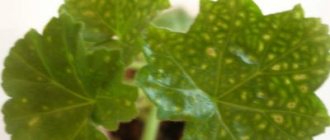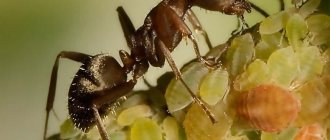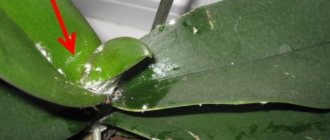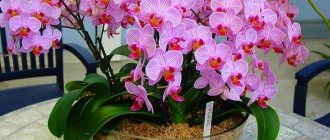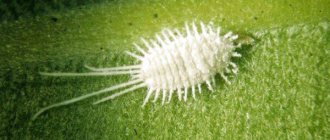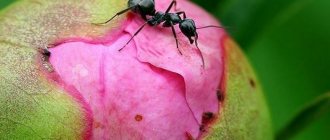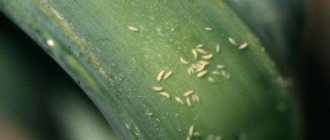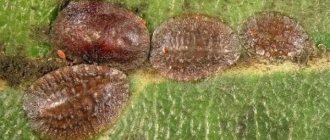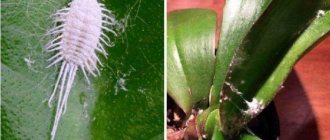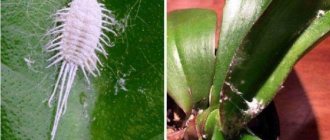Microscopic dark rods with wings on the leaf of any indoor plant cause alarm to the gardener. Thrips on orchids are no less dangerous from other pests; in order to effectively combat them, you need to understand their way of life, know what they look like, and why they appear again and again after several chemical treatments.
About 6 thousand species from the order Thrips, or vesicopods, are known in nature, united in almost 100 genera. In some old sources they are called fringed-winged or club-footed. They live everywhere, some species are predators that feed on spider mites, but most are dangerous plant pests. In the CIS countries, up to 300 species have been observed parasitizing agricultural and ornamental crops, including indoor crops.
Reasons for appearance
Thrips on orchids most often appear with the acquisition of a new plant . A florist can also bring them along with wild and garden flowers. In the photo below you can see the size of these pests.
Basically, thrips appear with the acquisition of a new plant.
Flowers located on the balcony at the height of the first two floors are at risk of infection by this pest.
IMPORTANT! When bringing flowers in after a summer of standing outdoors, you need to inspect them for the presence of pests and take preventive measures.
Photo
Next you can see photos of these pests on orchids:
You can learn more about the types of thrips and see their photos here.
Description of the adult insect and its larvae
The body length of an adult pest is only 0.5-1.5 mm, the size depends on the subspecies. Thrips are mobile insects , as they have legs equipped with special bubble devices. Why are they classified as bladder-footed? There are wings on the back, but the insect almost never uses them. There is an oral cavity adapted for sucking the juice of the plant.
Thrips development goes through various stages :
- Egg;
- Protonymph;
- Nymph;
- Imago.
The larva resembles an adult thrips, only :
- Painted light brown;
- And it has transparency.
IMPORTANT! In a year, in good housing conditions, up to 12 generations of the pest can grow.
Thrips development stages.
What other pests can be found in orchids?
- Root mite is a tiny insect that damages weakened plant species by burrowing into their tissue. The roots and base of the shoots rot in an infected plant. Very rare.
- Greenhouse flat beetle mite - most often affects leaves, acquiring a silvery-white color. Flowers and young leaves are deformed. When severely damaged by this pest, the orchid dries out.
- Woodlice are small crustaceans that live in the soil and leave the soil at night. There are small holes on young leaves, buds, flowers, which damages growth points, as well as young roots.
- Crickets are a rarely found pest in the home collection. They are similar to grasshoppers. From 1 to 4 cm in size from gray to black. Young leaves, buds and flowers have large, irregular holes. It also eats young roots.
- Podura are tiny insects jumping on the surface of the substrate, 1-2 mm in size, which are indicators of orchid flooding. They appear in acidic substrates and do not cause any harm. According to some reports, they are credited with damaging young roots.
- Tiny flies that feed mainly on decay products of the substrate. But their larvae can also damage healthy parts of the plant, in particular the roots.
- Caterpillars and worm-like insect larvae that are easy to spot. The edge of the sheet is corroded. There are passages in the tuberidia.
- Millipedes (millipedes) are long, worm-like insects with a huge number of legs. They live in the soil, coming to the surface only at night. There are small holes on young leaves, buds, flowers, which damages growth points, as well as young roots.
What is their danger?
The insect is very small in size, and while on the plant, they actively feed on its sap . Thrips carry various viruses and infections. Also, while on the orchid, they cover its leaves with a coating, which in turn:
- Prevents oxygen from entering plant cells;
- And it disrupts the process of photosynthesis.
The plant's immunity is noticeably reduced and the plant is attacked by fungi , which complete the death of the flower. Also, if there is damage on the buds in the form of small dark dots, then this is the appearance of thrips.
Thrips carry many different diseases and infections.
You can detect thrips by carefully examining the plant. If black dots are found on its leaf plates and the leaf is covered with a silvery coating, then this is a waste product of a pest. A noticeable signal of infection will be curved :
- Peduncles;
- New leaves;
- Underdeveloped buds.
Having seen these main signs, you need to carefully examine the plant, and then you will probably be able to notice the culprit of the damage to the orchid. After which treatment begins immediately .
Signs of defeat
Damage to orchids by thrips superficially resembles areas affected by spider mites. Insects pierce the outer shell of the leaf blades and suck the juice from the cells. Air enters them, and the affected areas become silvery-white, as if entangled in a microscopic cobweb. Over time, they turn brown or black, which indicates the most likely penetration of fungi through the punctures.
Damaged leaves will not be able to participate in photosynthesis and will soon die. When new shoots and flowering stems are affected by thrips, their deformation is observed, especially this phenomenon accompanies the appearance of tobacco and California thrips on orchids.
Fighting methods
Many beginners ask the question: how to get rid of thrips on an orchid? There are various ways and we will tell you about some of them.
Folk remedies
If the lesion is small or at this moment the grower for a number of reasons cannot use other means, you can try to get rid of the pest using folk remedies.
Soap solution
Take small natural laundry soap 72% and grate it.
When controlling pests, the orchid is sprayed with a soap solution.
Then it is mixed with warm water and is treated with this solution .
After using the solution, rinse it off with warm water after 15 minutes. Soap can also damage the leaves of the plant.
Reader's opinion: No folk remedies, let alone soap, will help get rid of thrips!
Tobacco tincture
To get rid of thrips, 100 gr. tobacco is brewed in a liter of water, infused for 24 hours and filtered. After that, treatments are carried out several times to make sure that the pest is defeated.
Decoction of Tagetes (Marigold)
The inflorescences are crushed, no more than 100 g. pour in a liter of water and bring to a boil. After that, turn off the fire, wrap the container with marigolds in a towel and let it brew for 3 days. After this time, the infusion is ready for use against thrips.
If folk remedies do not help in the fight against harmful insects, it must be removed in other ways . Also, folk remedies can spoil the appearance of the plant, as it clogs the leaves and they begin to deform.
Biological agents
In specialized stores you can find various biological preparations that contain predatory insects :
- Klopov;
- Ticks.
They are poured from a bag or test tube onto a damaged orchid, where they feed on thrips until they are completely destroyed.
Now many European companies produce biological products to combat pests, as they :
- Are effective;
- And they do not harm the environment.
These are predatory insects :
- Thrips Franklinothrips vespiformis;
- Orius bug.
The bug is one of the biological methods of destroying thrips.
These types of insects have come to be considered useful and are used in greenhouses to destroy common thrips.
IMPORTANT! But do not forget about preventive measures and place purchased plants in the quarantine zone.
Chemicals
The chemical industry has created many drugs that can remove thrips from a plant. They come in various forms :
- Granules;
- Powders;
- Emulsions that dissolve well in water.
Experienced gardeners often use :
- Aktar;
- Fitoverm ( insecticide
of contact-intestinal action).
These are drugs that effectively destroy the pest and do not cause harm to humans and their pets.
When diluting these drugs, you must follow the instructions and do not increase the dose. Also, the number of treatments should not deviate from what is indicated in the instructions on the package.
There are also many different drugs that can destroy thrips:
- Celaflor;
- Vertimek;
- Neudorf;
- Aktellik;
- Pyrethrum powder.
IMPORTANT! It must be remembered that treatments are carried out until the pest completely disappears. And if one drug does not help, you need to take another with a different active ingredient.
Risk level
Many chemicals are oil-based , which helps in fighting insects by blocking their airways. But this is also harmful for the leaf blades because without access to oxygen they cease to participate in the process of photosynthesis, which has a bad effect on the life of the orchid. The delicate leaves of certain types of orchids are especially affected.
We must not forget that chemicals also harm the orchid.
Therefore, the preparations must be used carefully, and if the appearance of the plant begins to deteriorate, you must :
- Change the drug;
- Or stop processing with chemicals altogether;
- And switch to folk remedies.
Experienced flower growers advise not to spray the preparations on the entire orchid, but to apply them pointwise to those places where the pest is noticed. This is necessary so that the plant has leaves that can engage in the process of photosynthesis.
Biological agents
- Spintor is a contact-intestinal natural insecticide. For preparation, use 2 ml of suspension, which is diluted in 5 liters of water. The bush is treated twice with irrigation at intervals of a week.
- Anthonem is a safe bioinsecticide. At least 10,000 invasive nematodes are required to treat one pot. Treatment is carried out by watering the substrate with a diluted solution. No re-processing required.
- Vermitek is an insectoacaricidal agent. To prepare the solution you will need 1 ml of the product diluted in 0.5 liters of water. The solution is sprayed onto the orchid bush twice, an interval of 3-4 days.
- Fitoverm is a biologically active preparation of the insectoacaricidal group. To prepare the solution, use 4 ml of product and 500 ml of water. The plant must be sprayed and then placed in a bag for two days. The treatment should be repeated three times with an interval of 5-7 days.
Prevention measures
First of all, newly purchased orchids are placed in a quarantine zone for 2 weeks to make sure that the plant is not infected with harmful insects.
Preventive measures:
- Quarantine measures;
- Warm shower for plants;
- Carrying out scheduled treatment before the winter period;
- Periodically inspect your collection for pests.
Important! When “bathing” phalaenopsis in the shower, water gets into the axils of the leaves, which can lead to rotting and death of the plant, so the water in the axils should be immediately blotted with cotton pads.
Preventive measures
Preventing the reappearance of thrips consists of the following measures:
- Any new plant that is brought into the house must first be kept in quarantine (1-3 weeks). If the flower was purchased through an online store, the quarantine should be stricter and longer.
- Try to change the soil under the purchased plant as quickly as possible. Also, for preventive purposes, store-bought soil can be calcined in the oven or frozen outside the window for 24 hours.
- If the plants tolerate cool water well, they can be washed in the shower at least 1-2 times a month.
Avoiding thrips can be quite difficult. Therefore, try to inspect the orchid as often as possible. This will help minimize the damage that parasites can cause to the plant.
Other methods for preventing the appearance of thrips on orchids:
- Since thrips love dry air, they will not reproduce in humid air, so reasonable humidification ;
- Sticky insect can be
- Replanting the purchased plant is required. This will help not only prevent rot on the root mass, but also remove pests found in the substrate.
Below is a brief summary of the temperature at which thrips are kept:
The optimal temperature for development is between 15 and 30 degrees Celsius. The minimum temperature at which an insect begins to manifest itself is 9 and a half degrees. Thrips go to winter as an imago inside a pot, or in buds as a larva. This can explain the stories of flower growers about how plants suffered from thrips all summer, and in the fall the pest receded. In some cases, the dependence of thrips on air temperature is used against it; plants are placed in conditions unsuitable for the development of the insect. However, not all plants tolerate low temperatures; in the case of phalaenopsis, this technique is not suitable. Dendrobium and cymbidium will tolerate the decline without problems. The lifespan of thrips ranges from 25 to 45 days.
Why do bladderpods appear on flower crops?
Orchids that are planted in the wrong soil are attacked by thrips . Particularly in soil that has too much moss. Sometimes inexperienced gardeners cover the entire surface of the soil with moss, which makes it difficult for air circulation in the flowerpot. Therefore, it is better to remove moss from the surface altogether. Thrips can also migrate from a newly arrived plant. If you just bought a new orchid, it is better to quarantine it for at least a month and carefully monitor it. This way you will protect the rest of the plants from infection.
